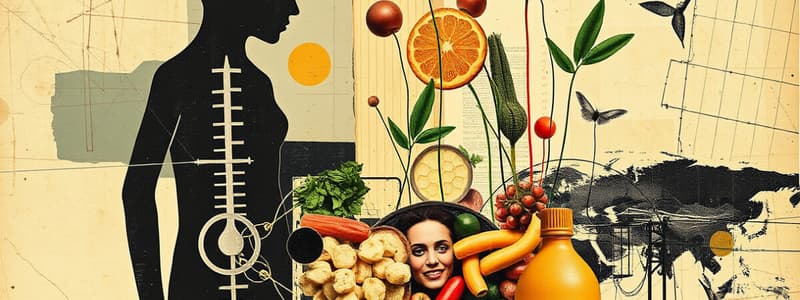Podcast
Questions and Answers
Which three classes of nutrients supply the body with energy?
Which three classes of nutrients supply the body with energy?
- Proteins (correct)
- Carbohydrates (correct)
- Vitamins
- Fats (correct)
Define the term metabolism. How is metabolism related to the nutrients in food?
Define the term metabolism. How is metabolism related to the nutrients in food?
Metabolism is the chemical process by which your body breaks down food to release energy.
What roles do carbohydrates, fats, and proteins play in the body?
What roles do carbohydrates, fats, and proteins play in the body?
Carbohydrates supply energy, fats provide energy and support cell function, and proteins aid in growth and repair of tissues.
What is cholesterol? How does diet affect cholesterol levels in the blood?
What is cholesterol? How does diet affect cholesterol levels in the blood?
Name some circumstances during which you might use your body's stores of glycogen?
Name some circumstances during which you might use your body's stores of glycogen?
How do saturated fats differ from unsaturated fats?
How do saturated fats differ from unsaturated fats?
What percentage of your total day's calories came from carbohydrates, fats, and protein if you consumed 2,500 calories?
What percentage of your total day's calories came from carbohydrates, fats, and protein if you consumed 2,500 calories?
What is stress? Explain how stress can be both positive and negative.
What is stress? Explain how stress can be both positive and negative.
When do people experience stress?
When do people experience stress?
What is meant by the term stressor?
What is meant by the term stressor?
List the four general types of stressors and give an example of each.
List the four general types of stressors and give an example of each.
What are vitamins? How do they differ from minerals?
What are vitamins? How do they differ from minerals?
What are the two classes of vitamins? Which vitamins fall into each class?
What are the two classes of vitamins? Which vitamins fall into each class?
Which seven minerals are needed by the body in significant amounts?
Which seven minerals are needed by the body in significant amounts?
What roles does water play in the body?
What roles does water play in the body?
Define homeostasis.
Define homeostasis.
What vitamins are supplied by green leafy vegetables? By citrus fruits?
What vitamins are supplied by green leafy vegetables? By citrus fruits?
What are some ways that people with high blood pressure can reduce their sodium intake?
What are some ways that people with high blood pressure can reduce their sodium intake?
Explain how feelings of thirst can help a person maintain homeostasis on a hot day.
Explain how feelings of thirst can help a person maintain homeostasis on a hot day.
What are the four main recommendations contained in the Dietary Guidelines for Americans?
What are the four main recommendations contained in the Dietary Guidelines for Americans?
Flashcards are hidden until you start studying
Study Notes
Nutrients and Energy
- Carbohydrates, fats, and proteins are the three classes of nutrients that provide energy to the body.
- Metabolism involves breaking down food into energy through chemical processes influenced by nutrients.
Nutritional Roles
- Carbohydrates are primarily energy sources for bodily functions.
- Fats provide energy, structure for cells, maintain body temperature, and protect nerves.
- Proteins are essential for growth and tissue repair.
Cholesterol and Dietary Impact
- Cholesterol is related to fat metabolism; a high-fat and high-cholesterol diet can elevate blood cholesterol levels.
Glycogen Usage
- Glycogen, stored in the body, is used as an energy source when fasting for 12 hours or when blood sugar levels drop.
Types of Fats
- Saturated fats contain single bonds in their chemical structure and are often found in dairy and meat.
- Unsaturated fats have one or more double bonds and are found in foods like walnuts and fish.
Caloric Breakdown
- In a 2,500 calorie diet, carbohydrates provide 48%, fats 35%, and protein 17% of total caloric intake.
Understanding Stress
- Stress is a physical and mental response to challenges or threats, with both positive (motivational) and negative (performance-decreasing) impacts.
- Stress can arise during major life changes, catastrophes, or everyday issues.
Types of Stressors
- Major life changes (e.g., graduating from college)
- Catastrophes (e.g., natural disasters like floods)
- Everyday problems (e.g., overwhelming homework assignments)
- Environmental problems (e.g., unsafe living conditions)
Vitamins and Minerals
- Vitamins are organic nutrients produced by living organisms, essential in small amounts for various body functions; minerals are inorganic and derived from soil and rocks.
- Vitamins are classified into two groups:
- Fat-soluble vitamins: A, D, E, K
- Water-soluble vitamins: B1, B2, B3, B6, B12, pantothenic acid, folate, biotin, and C
Essential Minerals
- Seven vital minerals for the body include calcium, sodium, potassium, magnesium, phosphorus, chlorine, and sulfur.
Role of Water
- Water is crucial for nearly all chemical reactions in the body, including energy production and tissue regeneration.
Homeostasis
- Homeostasis is the maintenance of a stable internal environment within the body.
Vitamins from Foods
- Green leafy vegetables provide vitamins K and E.
- Citrus fruits are rich in vitamins A and C.
Reducing Sodium Intake
- To decrease sodium intake, avoid high-sodium foods, especially for those with high blood pressure.
Thirst and Homeostasis
- Thirst signals the body to maintain hydration and thus supports homeostasis, especially in hot conditions.
Dietary Guidelines
- The Dietary Guidelines for Americans recommend making informed food choices and balancing caloric intake with physical activity.
Studying That Suits You
Use AI to generate personalized quizzes and flashcards to suit your learning preferences.




